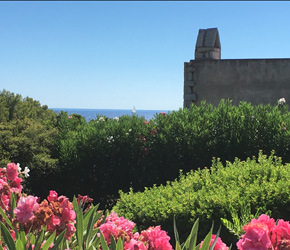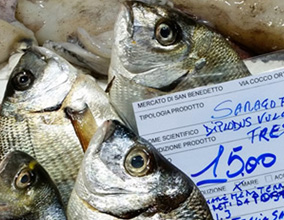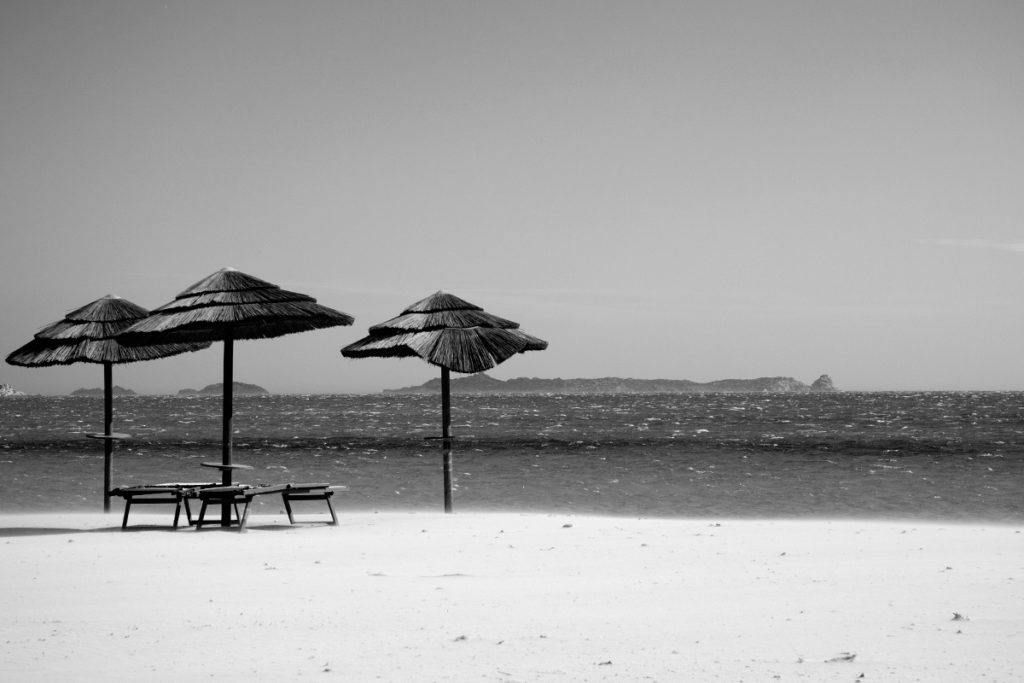It really does exist – the typical fragrance of Sardinia. It is said that anyone who has ever inhaled it understands this island. The blend of Mediterranean macchia and sea breezes on the one hand and the spectacular panorama of the crystal clear sea with its sandy white coast on the other hand really do create the perfect welcome committee for every vacationer.
Perfect beaches around Cagliari!
The region east of the island’s capital Cagliari is most definitely among the most beautiful in all of Sardinia. The scenery alternates between small bays and long sandy beaches. Located on the island’s southern coast, the vacation resorts of Torre delle Stelle and Geremeas offer absolute tranquility while the former fishing village of Villasimius radiates modern sophistication. And then, of course, there is Costa Rei – the King’s Coast in southeastern Sardinia: a family-friendly paradise.
It’s a good thing that tourism in Sardinia has progressed from north to south so that way – even during peak season in the summer – there is always enough space for everyone.
We would love to hear which one is your favorite resort in southeastern Sardinia. We would like to invite you to have a look at each resort: you will find detailed descriptions, lots of information and our expert tips here.
Every resort is unique, every resort represents Sardinia’s diversity. Every resort would love to welcome you!
Climate and temperature
The best time to travel is from April to September.
On the southern coast of Sardinia, it is safe to say that the swimming season lasts from Easter until the end of October. So the season is somewhat longer than in the northern part of the island. That is because there are substantial differences in temperature between the two halves of the island at the start and the end of the season. However, in the course of the summer those differences in temperature gradually disappear. Then – contrary to what people often assume – in mind summer the maximum temperatures in the south are by no means any higher than they are in the north. So there is no need to worry about excessive heat in the summer. Furthermore, the island winds ensure there is always a refreshing breeze.
Short Info
Sardinia is the second largest island of the Mediterranean Sea (Sicily is the largest) and belongs to Italy. Sardinia’s economy is based on services and agriculture. Sardinia has approx. 1.6 million inhabitants, and its coasts extend to more than 1.850 km length. The island has a total area of 24.000 square kilometres, and its capital Cagliari is to be found in the South.
What to eat in Sardinia?
Sardinia is a paradise for people who are fond of culinary delights. The most well-known specialities are Sardinia’s typical sheep’s milk cheese (Pecorino sardo) and suckling pig (maialetto arrossto).
Furthermore, Sardinia also produces excellent wines. Vermentino (a fruity white wine) and Cannonau (a heavy, dark red wine) can be highly recommended.
Sardinia’s history
The documented history of the island goes back as far as the Paleolithic period (8000 BCE). In the fourth millennium BCE, agricultural cultivation and the first trading with Southern France, Italy and Corsica began. As of 1800 BCE, beginning and expansion of the Nuragic culture. Even today great deal of evidence attesting to these “native inhabitants” of Sardinia can still be found. When the island was incorporated into the Roman Empire (250 BCE), a literally endless period of successively alternating rulers commenced. For example, for an interim period Sardinia belonged to the Byzantine empire (534 CE). It was occupied by the Arabs (as of 700 CE). Then it belonged to Spain (1479 CE) and subsequently to Austria (1713), until it finally came under Italian influence (as of 1720). Since 1948, Sardinia has been an autonomous region. 1962 was the dawn of tourism on the Costa Smeralda.
Daytime temperature
| Tagestemperatur in °C | |||||||||||
| Jan. | Feb. | März | April | Mai | Juni | Juli | Aug. | Sep. | Okt. | Nov. | Dez. |
| 14 | 15 | 17 | 20 | 23 | 28 | 31 | 31 | 28 | 24 | 19 | 15 |
| Wassertemperatur in °C | |||||||||||
| Jan. | Feb. | März | April | Mai | Juni | Juli | Aug. | Sep. | Okt. | Nov. | Dez. |
| 14 | 13 | 14 | 15 | 17 | 20 | 23 | 24 | 23 | 21 | 18 | 15 |
| Sonnenstunden pro Tag | |||||||||||
| Jan. | Feb. | März | April | Mai | Juni | Juli | Aug. | Sep. | Okt. | Nov. | Dez. |
| 5 | 5 | 6 | 8 | 9 | 10 | 11 | 10 | 8 | 7 | 5 | 4 |
| Regentage | |||||||||||
| Jan. | Feb. | März | April | Mai | Juni | Juli | Aug. | Sep. | Okt. | Nov. | Dez. |
| 7 | 7 | 6 | 5 | 5 | 2 | 1 | 1 | 3 | 6 | 7 | 8 |










